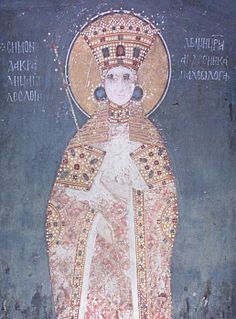 W
WConstantine Bodin was the ruler of Duklja, from 1081 to 1101, succeeding his father, Mihailo Vojislavljević. Born in peaceful times, when the Southern Slavs were subjects of the Byzantine Empire, his father was in 1072 approached by Bulgarian nobility, who sought aid in their revolt against the Byzantines; Mihailo sent them Bodin, who was crowned Bulgarian tsar under the name Petar III joined the short-lived revolt, being captured the following year after initial success. He was freed in 1078, and upon the death of his father in 1081 he succeeded to the throne of Dioclea. Having renewed his acknowledgement of Byzantine overlordship, he soon sided with their enemies, the Normans, which resulted in a Byzantine invasion and his capture. Although he quickly had himself freed, his reputation and influence waned. He was pushed aside into by one of his governors, Vukan, who continued the struggle against the Byzantines.
 W
WKatarina Branković, also known as Kantakuzina was the Countess of Celje, through the marriage with Count of Celje Ulrich II. A Serbian princess, she was the daughter of Despot Đurađ Branković and Byzantine princess Irene Kantakouzene. She is remembered for writing the Varaždin Apostol (1454), and her endowment of the Rmanj Monastery.
 W
WMara Branković or Mara Despina Hatun, also known as Sultana Marija or Amerissa, was the daughter of Serbian monarch Đurađ (George) Branković and Eirene Kantakouzene. She entered the harem of Sultan Murad II of the Ottoman Empire. During the second reign of her step-son Mehmed the Conqueror, she held the position of Valide Hatun, a title equivalent to the later Valide Sultan which means queen mother.
 W
WStefan Branković, also known in historiography as Stefan the Blind, was briefly the despot (ruler) of the Serbian Despotate between 1458 and 1459, member of the Branković dynasty.
 W
WIrene Kantakouzene, known simply as Despotess Jerina, was the wife of Serbian Despot Đurađ Branković. In Serbian folk legends, she is the founder of many fortresses in Serbia.
 W
WJovan Oliver Grčinić was a magnate of the Serbian Emperor Dušan the Mighty, holding the titles of sebastokrator and despotes, and the rank of "great voivode", showing his prominence and status as one of the most important nobles of Dušan. Oliver supported Dušan in the succession war against his father, and was one of the supreme generals in the southern military expeditions. His province included Ovče Pole and the left bank of the Vardar. After the death of Emperor Dušan, there are no more mentions of Oliver. During the fall of the Serbian Empire, his lands were held by the Dejanovići.
 W
WSimonida Nemanjić, born Simonis Palaiologina, was a Byzantine princess and queen consort of the Kingdom of Serbia as the fourth wife of Serbian king Stefan Milutin. She was a daughter of the Byzantine Emperor Andronikos II Palaiologos and Irene of Montferrat. In Medieval Serbia Simonida is best remembered as a patron of the Arts, Music and Literature.
 W
WJelena Šubić was the daughter of Stefan Uroš III Dečanski of Serbia and the half-sister of Stefan Dušan. She was married to the Croatian magnate Mladen III Šubić, Prince of Bribir from noble Šubić family. They ruled from Klis Fortress in Dalmatia. After Mladen III Šubić's death, she ruled as his widow over Skradin and Klis.
 W
WJovan Uroš Nemanjić or John Ouresis Doukas Palaiologos or Joasaph of Meteora, was the ruler of Thessaly from c. 1370 to c. 1373, thereafter retiring as a monk. He died in 1422.